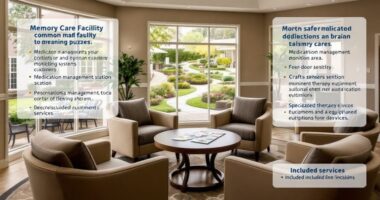When choosing assisted living for dementia care, you'll need to evaluate five essential criteria: specialized memory care units with dedicated supervision, staff qualifications including Dementia Care Practitioner credentials, extensive security systems for wandering prevention, cognitive engagement programs featuring evidence-based activities, and dementia-friendly environmental design. Focus on facilities with high staff-to-resident ratios, consistent care teams, and integrated medical services. Further analysis of these components reveals significant distinctions among care facilities.

When confronting the complex decision of selecting an assisted living facility for a loved one with dementia, understanding the multifaceted components of specialized memory care becomes paramount. Memory care units provide more comprehensive supervision than traditional assisted living facilities.
Finding the right memory care facility requires a comprehensive understanding of specialized care components to make an informed, compassionate choice.
You'll need to evaluate facilities' capacity to provide specialized dementia care units, particularly for advanced Alzheimer's cases, while considering geographical proximity to guarantee regular family visitation and access to thorough medical services. Ensuring a location with easy access to recreational activities can greatly enhance quality of life.
The qualification metrics of staff members serve as critical indicators of care quality, with particular emphasis on the certification status of caregivers as Dementia Care Practitioners and the facility's staff-to-resident ratio. The staff should demonstrate proficiency in assisting residents with activities of daily living.
You'll want to scrutinize staff turnover rates and verify the implementation of ongoing education programs that keep caregivers current with evolving dementia care methodologies.
Security infrastructure demands meticulous evaluation, including wandering prevention systems, thorough emergency protocols, and surveillance mechanisms.
You should assess the integration of multiple safety layers, from secured entry points to sophisticated monitoring systems that maintain resident protection while preserving dignity.
The facility's approach to cognitive engagement warrants careful analysis through their implementation of evidence-based memory-stimulating activities and therapeutic interventions.
You'll need to evaluate their methodology for grouping residents by cognitive function and verify the availability of secure outdoor spaces that facilitate supervised mobility and sensory stimulation.
The physical environment's design elements require assessment for dementia-friendly features, including intuitive navigation systems and calming visual cues.
You should examine the range of living arrangements, from private suites to companion rooms, and evaluate the integration of assistive technologies that enhance resident independence and safety.
Medical service delivery systems constitute a fundamental consideration, encompassing on-site nursing coverage, medication management protocols, and established relationships with healthcare providers.
You'll need to verify the facility's capacity for handling medical emergencies and their ability to provide specialized services as your loved one's needs evolve, including the potential integration of hospice care when necessary.
Frequently Asked Questions
How Long Does It Typically Take to Adjust to Assisted Living?
You'll typically experience a 3-6 month adjustment period in assisted living, though individual factors greatly influence this timeline.
During the initial few weeks, you'll focus on acclimating to routines and building relationships with staff and residents.
Your adjustment duration correlates with health status, cognitive function, facility quality, and family support frequency, with regular visits accelerating adaptation by up to 40%.
Can Couples Stay Together if Only One Has Dementia?
Yes, you'll find multiple options for staying together when one partner has dementia.
Many communities offer arrangements where couples can share an apartment with individualized care plans, costing approximately 80% more than single occupancy.
Alternatively, you can choose mixed living arrangements within the same campus – with one partner in assisted living while the other receives specialized memory care, allowing for frequent visits while ensuring appropriate support.
What Happens if Our Financial Resources Run Out During Care?
When your financial resources deplete, you'll need to explore Medicaid coverage, which becomes available once you've spent down assets to qualifying levels.
You'll likely need to shift to Medicaid-certified facilities, as 97% of monthly income typically goes toward care costs.
Consider exploring alternative options like family caregiving or community-based programs that offer financial assistance, though these may require significant adjustments to current care arrangements.
Are Residents Allowed to Bring Their Pets to Assisted Living?
Most assisted living facilities allow pets, but you'll need to verify specific policies regarding size restrictions, breeds, and required documentation.
You're typically permitted one pet that meets the facility's guidelines, though you must demonstrate your ability to provide independent care.
Many communities charge monthly pet fees ($200-500 initially, plus $20-50 monthly) and require proof of vaccinations, licensing, and a thorough pet care backup plan.
How Often Can Family Members Stay Overnight With Their Loved Ones?
Overnight stay policies vary considerably among assisted living communities, with most facilities allowing family visits 2-4 times monthly, subject to advance scheduling.
You'll need to verify specific guidelines, as communities typically require 24-48 hours' notice and may limit consecutive stays to 2-3 nights.
Guest accommodation fees range from $25-75 per night, with extended stay options available during changeover periods or special circumstances.









